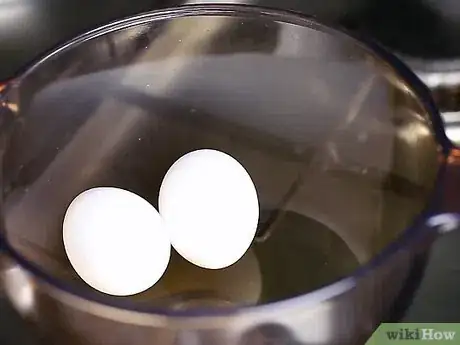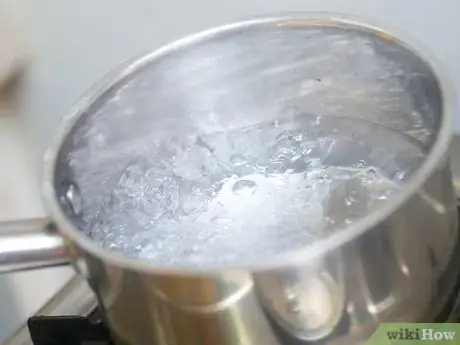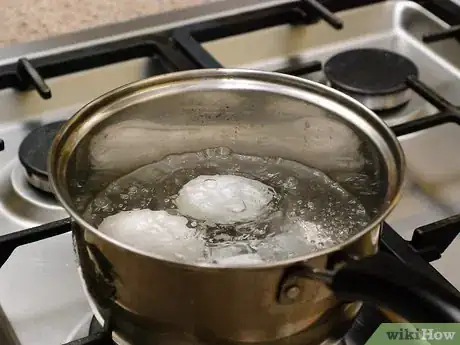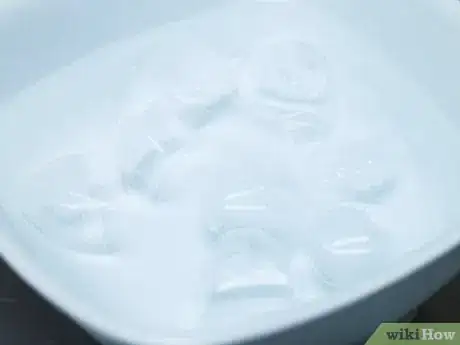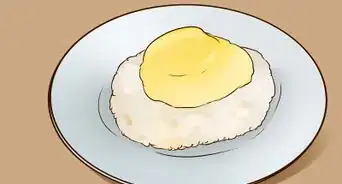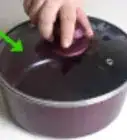This article was co-authored by wikiHow Staff. Our trained team of editors and researchers validate articles for accuracy and comprehensiveness. wikiHow's Content Management Team carefully monitors the work from our editorial staff to ensure that each article is backed by trusted research and meets our high quality standards.
There are 7 references cited in this article, which can be found at the bottom of the page.
wikiHow marks an article as reader-approved once it receives enough positive feedback. In this case, several readers have written to tell us that this article was helpful to them, earning it our reader-approved status.
This article has been viewed 172,362 times.
Learn more...
Have you ever cooked a tasty egg, only to try and peel it, and end up with chips and craters? If you are making an egg salad, a messed up egg white may not be an issue. If are making deviled eggs, however, a messed up egg white will take away from the overall appearance. Luckily, there are a few simple tricks you can use to boil eggs so that they peel easily and neatly.
Steps
Giving the Eggs a Cold Start
-
1Place your eggs in a single layer in a saucepan. Try to use eggs that are at least 7 to 10 days old. Many people find that the fresher an egg is, the more difficult it is to peel.
-
2Cover the eggs with 2 inches (5.08 centimeters) of cold water.[1] How much water you end up using will depend on how big the saucepan is and how many eggs you are cooking. Whatever you use, make sure that the eggs are under 2 inches (5.08 centimeters) of water. If you don't use enough water, the eggs may not cook evenly.[2]Advertisement
-
3Bring the water to a boil over high heat. This will help the eggs cook slowly at first. They will continue to cook, even after you turn the heat off later on.
-
4Turn the stove off, cover the saucepan with a lid, and wait 11 to 13 minutes. Keep the saucepan on the burner during this time. The heat from the burner will continue "cooking" the eggs. If your burner doesn't stay hot after you turn it off (such as gas), reduce the heat to low, simmer for 1 minute, then turn it off.[3]
- If the eggs are small or medium-sized, cook them for 11 minutes.
- If the eggs are large or extra large, cook them for 13 minutes.[4]
-
5Prepare an ice bath. Fill a large bowl with cold water and lots of ice. When you put the eggs into this, the coldness will "shock" the eggs, and make the shell easier to peel off.
-
6Carefully transfer the eggs to the ice bath and wait 5 to 15 minutes. Use a slotted spoon or a pair of tongs to lift the eggs out of the water and place them into the bowl. During this time, the eggs will cool down; cold eggs are easier to peel than hot eggs.
-
7Pull the eggs out of the water and set them down someplace where they won't roll away. Keep the bowl of water handy. You can dip the eggs into the water once you peel them to get rid of any broken shell bits.
-
8Crack the shell first, but don't peel it. Try to crack both ends of the shell first, as this is where the air pockets tend to be. To make the shell even easier to peel, roll the egg across the counter with your palm. This will help loosen the membrane from the whites.[5]
-
9Carefully peel the shell away from the egg. From time to time, dip the egg into the cold water. This will help loosen the shell from the whites even more. It will also help rinse away any broken shell fragments that might be stuck the to whites.
-
10Dry the eggs off with a paper towel. At this point, you can use the eggs in your recipe, or you can store them in a sealed container in your fridge. If you do store them, be sure to eat them within 3 to 5 days.
-
11Bon Appetit!
Giving the Eggs a Hot Start
-
1Fill a medium-sized saucepan halfway with water and bring it to a boil over high heat. Don't add the eggs to the water yet; it needs to be boiling first.
-
2Gently place the eggs into the water. Avoid dropping them into the water, or you will risk cracking them. Instead, consider using a slotted spoon, a pair of tongs, or even a wire basket.
-
3Reduce the heat to a simmer and cook for 11 to 13 minutes. If the eggs are smaller, cook them for 11 minutes. If the eggs are larger, cook them for 13 minutes.
-
4Prepare an ice bath while the eggs are cooking. Fill a bowl with cold water, and lots of ice. When you put the cooked eggs into the icy water, the coldness will "shock" the eggs, and make the shell easier to peel away.
-
5Place the cooked eggs into the ice bath, and wait 5 to 15 minutes. Once the time is up, use a pair of tongs or a slotted spoon to transfer the eggs from the saucepan and into the ice bath. During this time, the eggs will cool down; it is easier to peel cold eggs than hot eggs.
-
6Take the eggs out of the ice bath and set them down someplace where they won't roll away. Keep the ice bath nearby. You can dip the eggs into the water after you peel them to get rid of any broken shell bits.
-
7Crack the egg, then roll it across a hard surface. Tap both ends of the egg against a hard surface, then roll the egg across the surface with your palm. This will help loosen the membrane from the whites, and make the egg easier to peel.
-
8Peel the shell away from the egg. You may want to dip the egg into the cold water from time to time. This will loosen the shell from the whites even more, and help rinse away any broken shell pieces. [6]
-
9Dry the eggs off with a paper towel. At this point, you can add the eggs to your recipe, or store them in a sealed container in the refrigerator. If you do store them, be sure to eat them within 3 to 5 days.
-
10Finished.
Community Q&A
-
QuestionWhat do I do if it's still difficult to peel?
 Community AnswerCrack the shell, but don't peel it and place the egg back in the cold water for 5 minutes, then try peeling the shell. The water will get between the shell and whites and make it easier to peel.
Community AnswerCrack the shell, but don't peel it and place the egg back in the cold water for 5 minutes, then try peeling the shell. The water will get between the shell and whites and make it easier to peel. -
QuestionCan the boiled eggs be stored in the shell in the refrigerator?
 Community AnswerYes of course! Just don't leave it in the refrigerator for too long.
Community AnswerYes of course! Just don't leave it in the refrigerator for too long. -
QuestionIs there a faster way to peel eggs?
 Community AnswerNot really. Older eggs tend to peel easier than fresh ones.
Community AnswerNot really. Older eggs tend to peel easier than fresh ones.
Warnings
- Be very careful when you are moving the eggs from the hot water to the cold water; you should never use your hands as the eggs are extremely hot.⧼thumbs_response⧽
- If the uncooked egg floats in cold water, it probably went bad, so discard it.⧼thumbs_response⧽
Things You'll Need
- Eggs
- Water
- Saucepan
- Ice
- Bowl
- Tongs, slotted spoon, or wire basket
References
- ↑ http://www.simplyrecipes.com/recipes/how_to_make_perfect_hard_boiled_eggs
- ↑ http://www.momables.com/how-to-make-easy-to-peel-hard-boiled-eggs/
- ↑ http://www.simplyrecipes.com/recipes/how_to_make_perfect_hard_boiled_eggs
- ↑ http://www.momables.com/how-to-make-easy-to-peel-hard-boiled-eggs/
- ↑ http://comfortablydomestic.com/2013/03/perfect-hard-boiled-eggs/
- ↑ http://thepioneerwoman.com/food-and-friends/easy-to-peel-eggs/
- ↑ http://www.melskitchencafe.com/perfect-easy-peel-hard-boiled-eggs/
- ↑ http://www.simplyrecipes.com/recipes/how_to_make_perfect_hard_boiled_eggs
- ↑ http://www.simplyrecipes.com/recipes/how_to_make_perfect_hard_boiled_eggs
About This Article
To boil an egg so it peels easily, first tap the bottom of it on a hard surface to make a small crack. Place it in a saucepan, cover it with water, and bring the water to a boil. Turn off the heat once the water starts boiling and let the egg cook for about 12 minutes. Then, use a spoon to transfer the egg to a plastic container. Fill the container with hot water, put the lid on, and shake it for about 10 seconds. The egg shell should come right off in the container. Take the lid off, remove the peeled egg, and enjoy! If you want to learn how to start your eggs in hot water, keep reading the article!
